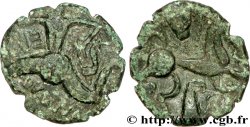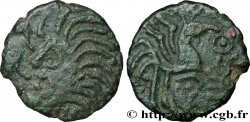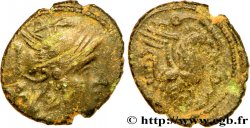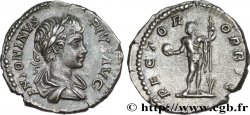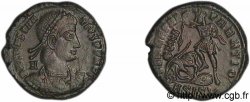v15_1073 - GALLIA BELGICA - BELLOVACI (Area of Beauvais) Plaque imitant le potin “à la cigarette”
MONNAIES 15 (2002)
Starting price : 155.00 €
Estimate : 400.00 €
Realised price : 155.00 €
Number of bids : 1
Maximum bid : 587.00 €
Starting price : 155.00 €
Estimate : 400.00 €
Realised price : 155.00 €
Number of bids : 1
Maximum bid : 587.00 €
Type : Plaque imitant le potin “à la cigarette”
Date: c. 50-20 AC.
Mint name / Town : Beauvais (60)
Metal : potin
Diameter : 24,5 mm
Weight : 3,93 g.
Rarity : UNIQUE
Coments on the condition:
Patine verte avec de minuscules oxydations rougeâtres au revers. Objet tout à fait exceptionnel
Catalogue references :
Obverse
Obverse legend : ANÉPIGRAPHE.
Obverse description : Tête à droite, les cheveux marqués de petits traits ; devant la bouche, sorte de chevron (cigarette) ; le tout entouré d’un disque circulaire embouti avec grènetis.
Reverse
Reverse legend : ANÉPIGRAPHE.
Reverse description : Lisse et en creux.
Commentary
Cet objet a sa place dans MONNAIES XV. Il copie ou imite un potin gaulois des Bellovaques, très proche du type "à la cigarette”. Des objets techniquement comparables auraient été découverts dans des sépultures de l'époque mérovingienne. Les monnaies gauloises se retrouvent couramment dans les tombes mérovingiennes. Cette parure pourrait très bien être le dessus d'une fibule, dont il manque l'ardillon, réalisée par un artisan (de l'époque gauloise à l'époque médiévale) séduit par l'iconographie du potin celtique dit “à la cigarette” qu'il aurait eu entre les mains.
This object has its place in COINS XV. It copies or imitates a Gallic potin of the Bellovaci, very close to the \\\"cigarette\\\" type. Technically comparable objects have been discovered in burials from the Merovingian period. Gallic coins are commonly found in Merovingian tombs. This ornament could very well be the top of a fibula, missing the barb, made by a craftsman (from the Gallic period to the medieval period) attracted by the iconography of the Celtic potin called \\\"cigarette\\\" that he would have had in his hands
This object has its place in COINS XV. It copies or imitates a Gallic potin of the Bellovaci, very close to the \\\"cigarette\\\" type. Technically comparable objects have been discovered in burials from the Merovingian period. Gallic coins are commonly found in Merovingian tombs. This ornament could very well be the top of a fibula, missing the barb, made by a craftsman (from the Gallic period to the medieval period) attracted by the iconography of the Celtic potin called \\\"cigarette\\\" that he would have had in his hands








 Report a mistake
Report a mistake Print the page
Print the page Share my selection
Share my selection Ask a question
Ask a question Consign / sell
Consign / sell
 Full data
Full data

